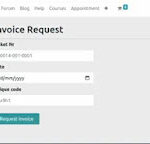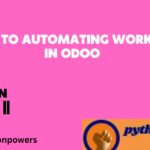Inventory Management With Odoo
Inventory is the heart of the business, it is from here all other parts of the business get sufficient
energy to live. If properly managed, the business remains healthy, otherwise always messy. Odoo
inventory management is a resourceful module which can be utilized by any business
organization irrespective of their size. It is designed in such a flexible manner. Odoo inventory is
fully integrated with other applications, such as Purchase, Sales or Inventory. But is not limited
to those processes, it is also fully integrated with our e-Commerce, Manufacturing and Repairs
applications . To Access inventory and warehouse management module in your ERP, you have
to install ‘Inventory Management’ app from Odoo.
Odoo inventory management makes a worthy product to use because of the following features.
. Clean and Fast
Odoo Double entry inventory management, flexible design, modern user interface, mobile
control and tracking mechanisms make Odoo a clean and fast performing ERP.
. Basic operation support
Prepare delivery order in simple steps, control and manage incoming shipments, prepare
inventory counts (cycle counts), multiple location management, barcode-based packing,
efficient scrap management, stock transfer option etc. Odoo support all the basic and
advanced operations takes place in a warehouse.
. Advanced Routing
Odoo advanced routing support operations like
Drop-shipping
Deliver to customers straight from your supplier based on products, orders or customers.
Cross-Docking
Unload incoming material and directly transfer to outbound gates with little to no storage
in between.
Put away & Removal strategies
Define your own storage and removal strategies; FIFO, nearest available zone, LIFO, etc.
Pick – Pack – Ship
Design your own order process flow. Deliver to customers in one step (delivery order) or
several steps: picking, packing, and shipping.
Push & Pull Routes
Design your own product routes to automate transfer orders between warehouses or
locations.
Multi-Warehouses
Manage all your warehouses with the same system and define replenishment rules
between warehouses.
. Replenishments
To keep your inventory properly replenished, Odoo provides options like
Minimum Stock
Have proposition of purchase orders (or request for quotations) created by Odoo based
on your future stock forecast.
Purchase Propositions
Get purchase order propositions based on supplier lead times, product demand and
inventory forecasts.
Make-to-Order
Purchase raw materials or manufacture products to order. Define your own routes specific
to warehouses, products, orders, etc.
Request for Quotations
Want to negotiate a price with suppliers every time you buy a specific product? Odoo can
trigger request for quotations automatically based on future needs.
. Traceability
Tracking your product inside and outside the inventory is a challenging task. But Odoo
traceability features like ‘Lots Tracking’, ‘Activity Log’, ‘Serial Numbers’, ‘Perpetual valuation’
make it easier for you.
. Product Management Features
Product Types
Odoo supports several product types that have different behavior: physical products,
consumables, services, digital products.
Kits
Odoo’s kitting features allows your salesperson to sell a kit, but you will deliver a set of
products.
Custom fields
Add as many custom fields as you want on products to handle your business needs.
Multi-Level Variants
Define multiple level variants in just a few clicks. Create matrix based on colors, sizes,
attributes, etc.
Multiple unit of measures
Odoo supports multiple unit of measures and converts automatically for you: buy a pallet
of beer, sell packs of beers.
Expiration Dates
Track expiration dates on products.
Multiple barcodes
Create custom barcodes with specific codes to implement desired behaviors, such as a
specific promotion.
. Business intelligence
The capability of Odoo BI and reporting tools are already explained in many modules. Odoo
BI tools perform similar admirable jobs here in Manufacturing module by providing reports
like inventory forecast, customer transaction drilldown reports, perpetual inventory
valuation reports etc.
If we compare Odoo Inventory with proprietary ERP Microsoft Dynamics, we can that find
many features like Freight Carrier Integration, Consignee stock management, etc. are not
available there. And if the comparison is between SAP and Odoo, Odoo has the advantage of
features like multiple variant support, Up and Down traceability, more effective barcode
support etc.
Before going to the detailed operations of Odoo inventory management, let’s first explore
some of the terms used in the modules. It will give you a better understanding about working
Odoo Inventory management system.
Warehouse: A warehouse in Odoo is a location where you store products. It is either a physical
or a virtual warehouse. It could be a store or a repository.
Location: Locations are used to structure storage zones within a warehouse. In addition to
internal locations (your warehouse), Odoo has locations for suppliers, customers, inventory loss
counter-parts, etc.
Lots: Lots are a batch of products identified with a unique barcode or serial number. All items of
a lot are from the same product. (E.g. a set of 24 bottle) Usually, lots come from manufacturing
order batches or procurements.
Serial Number: A serial number is a unique identifier of a specific product. Technically, serial
numbers are similar to having a lot of 1 unique item.
Unit of Measure: Define how the quantity of products is expressed. Meters, Pounds, Pack of 24,
Kilograms etc. Unit of measure of the same category (ex: size) can be converted to each other’s
(m, cm, mm) using a fixed ratio.
Consumable: A product for which you do not want to manage the inventory level (no quantity
on hand or forecasted) but that you can receive and deliver. When this product is needed Odoo
suppose that you always have enough stock.
Stockable: A product for which you want to manage the inventory level
Package: A package contains several products (identified by their serial number/lots or not).
Example: a box containing knives and forks.
Procurement: A procurement is a request for a specific quantity of products to a specific location.
Procurement are automatically triggered by other documents: Sale orders, Minimum Stock Rules,
and Procurement rules. You can trigger the procurement manually. When procurements are
triggered automatically, you should always pay attention for the exceptions (e.g. a product
should be purchased from a vendor, but no supplier is defined).
Routes: Routes define paths the product must follow. Routes may be applicable or not,
depending on the products, sales order lines, warehouse, etc. To fulfill a procurement, the system
will search for rules belonging to routes that are defined in the related product/sale order.
Push Rules: : Push rules trigger when products enter a specific location. They automatically move
the product to a new location. Whether a push rule can be used depends on applicable routes.
Procurement Rules or Pull Rules: Procurement rules describe how procurements on specific
locations should be fulfilled e.g.: where the product should come from (source location), whether
the procurement is MTO or MTS etc.
Procurement Group: Routes and rules define inventory moves. For every rule, a document type
is provided: Picking, Packing, Delivery Order, Purchase Order etc. Moves are grouped within the
same document type if their procurement group and locations are the same.
Stock Moves: Stock moves represent the transit of goods and materials between locations
Quantity On Hand: The quantity of a specific product that is currently in a warehouse or location.
Forecasted Quantity: The quantity of products you can sell for a specific warehouse or location.
It is defined as the Quantity on Hand – Future Delivery Orders + Future incoming shipments +
Future manufactured units.
Reordering Rules: It defines the conditions for Odoo to automatically trigger a request for
procurement (buying at a supplier or launching a manufacturing order). It is triggered when the
forecasted quantity meets the minimum stock rule.
Cross-Dock: Cross-docking is a practice in the logistics of unloading materials from an incoming
semi-trailer truck or railroad car and loading these materials directly into outbound trucks,
trailers, or rail cars, with no storage in between. (Does not go to the stock, directly from incoming
to packing zone)
Drop-Shipping: move products from the vendor/manufacturer directly to the customer (could
be retailer or consumer) without going through the usual distribution channels. Products are sent
directly from the vendor to the customer, without passing through your own warehouse.
Removal Strategies: the strategy to use to select which product to pick for a specific operation.
Example: FIFO, LIFO, FEFO.
Put away Strategies: the strategy to use to decide in which location a specific product should be
set when arriving somewhere. (Example: cables goes in rack 3, storage A)
Scrap: A product that is broken or outdated. Scrapping a product removes it from the stock.
Product variant: Basically, we have two methods to add a product. Product with “Variant” option
and standalone product. For example, if you want to add two products say iPhone 7 black,
iPhone7 white, to your system. Here you may add two different products or two variants under
a single product. Definitely later is the convenient method. To enable this feature, see the topic
configurations.
ware house were different types of actions are done. You can add single or multiple locations.
A location means a space in the warehouse, a shelf, a floor, etc. A location is part of one
warehouse and it is not possible to link to another warehouse. Actually all In and Out
transactions are carried out and Recorded through Locations. (If you look into Purchase order,
you can see Deliver to option, which essentially indicate a location)


















.jpeg)





